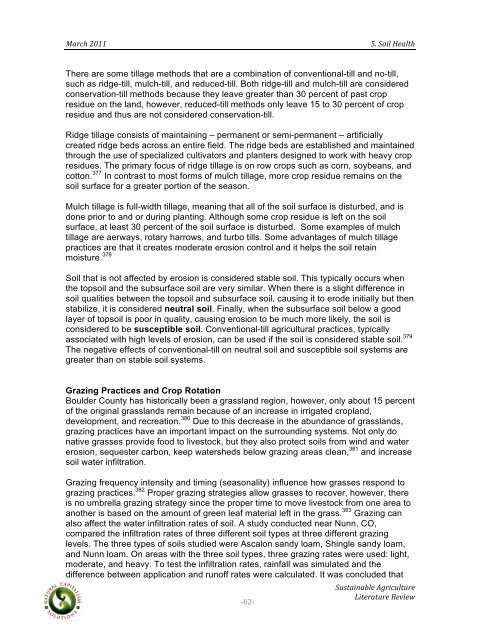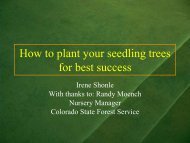Sustainable Agriculture Literature Review - Boulder County
Sustainable Agriculture Literature Review - Boulder County
Sustainable Agriculture Literature Review - Boulder County
You also want an ePaper? Increase the reach of your titles
YUMPU automatically turns print PDFs into web optimized ePapers that Google loves.
! !!<br />
"#$%&!'())!! !!!!!!!!!!!!!!!!!!!!!!!!!!!!!!!!!!!!!!!!!!!!!!!!!!!!!!!!!!!!!!!!!!!!!!!!!*+!,-./!01#/2&!<br />
There are some tillage methods that are a combination of conventional-till and no-till,<br />
such as ridge-till, mulch-till, and reduced-till. Both ridge-till and mulch-till are considered<br />
conservation-till methods because they leave greater than 30 percent of past crop<br />
residue on the land, however, reduced-till methods only leave 15 to 30 percent of crop<br />
residue and thus are not considered conservation-till.<br />
Ridge tillage consists of maintaining – permanent or semi-permanent – artificially<br />
created ridge beds across an entire field. The ridge beds are established and maintained<br />
through the use of specialized cultivators and planters designed to work with heavy crop<br />
residues. The primary focus of ridge tillage is on row crops such as corn, soybeans, and<br />
cotton. 377 In contrast to most forms of mulch tillage, more crop residue remains on the<br />
soil surface for a greater portion of the season.<br />
Mulch tillage is full-width tillage, meaning that all of the soil surface is disturbed, and is<br />
done prior to and or during planting. Although some crop residue is left on the soil<br />
surface, at least 30 percent of the soil surface is disturbed. Some examples of mulch<br />
tillage are aerways, rotary harrows, and turbo tills. Some advantages of mulch tillage<br />
practices are that it creates moderate erosion control and it helps the soil retain<br />
moisture. 378<br />
Soil that is not affected by erosion is considered stable soil. This typically occurs when<br />
the topsoil and the subsurface soil are very similar. When there is a slight difference in<br />
soil qualities between the topsoil and subsurface soil, causing it to erode initially but then<br />
stabilize, it is considered neutral soil. Finally, when the subsurface soil below a good<br />
layer of topsoil is poor in quality, causing erosion to be much more likely, the soil is<br />
considered to be susceptible soil. Conventional-till agricultural practices, typically<br />
associated with high levels of erosion, can be used if the soil is considered stable soil. 379<br />
The negative effects of conventional-till on neutral soil and susceptible soil systems are<br />
greater than on stable soil systems.<br />
Grazing Practices and Crop Rotation<br />
<strong>Boulder</strong> <strong>County</strong> has historically been a grassland region, however, only about 15 percent<br />
of the original grasslands remain because of an increase in irrigated cropland,<br />
development, and recreation. 380 Due to this decrease in the abundance of grasslands,<br />
grazing practices have an important impact on the surrounding systems. Not only do<br />
native grasses provide food to livestock, but they also protect soils from wind and water<br />
erosion, sequester carbon, keep watersheds below grazing areas clean, 381 and increase<br />
soil water infiltration.<br />
Grazing frequency intensity and timing (seasonality) influence how grasses respond to<br />
grazing practices. 382 Proper grazing strategies allow grasses to recover, however, there<br />
is no umbrella grazing strategy since the proper time to move livestock from one area to<br />
another is based on the amount of green leaf material left in the grass. 383 Grazing can<br />
also affect the water infiltration rates of soil. A study conducted near Nunn, CO,<br />
compared the infiltration rates of three different soil types at three different grazing<br />
levels. The three types of soils studied were Ascalon sandy loam, Shingle sandy loam,<br />
and Nunn loam. On areas with the three soil types, three grazing rates were used: light,<br />
moderate, and heavy. To test the infiltration rates, rainfall was simulated and the<br />
difference between application and runoff rates were calculated. It was concluded that<br />
!<br />
"%("<br />
!,342#.5#6/1!78$.%3/23$1!<br />
9.21$#23$1!:1;.1
















